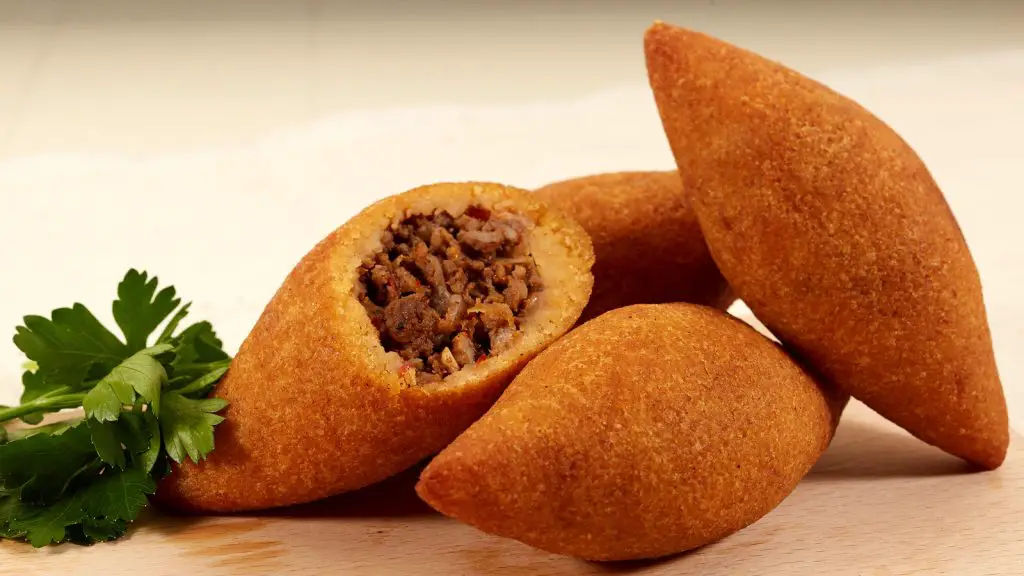Kibbeh is a beloved Middle Eastern dish that has captured the hearts and palates of people around the world. This delectable treat combines ground meat, typically beef or lamb, with bulgur wheat and an array of aromatic spices to create a flavorful and satisfying dish. With its rich history and numerous variations, kibbeh has become a symbol of Middle Eastern cuisine, reflecting the region’s culinary diversity and depth. In this article, we will explore the origins of kibbeh, its various preparations, and provide you with a step-by-step guide to making this mouthwatering dish at home.
The Origins of Kibbeh
Kibbeh’s roots trace back to the Middle East, where it has been a staple for centuries. This dish is thought to have originated in the Levant region, encompassing modern-day Syria, Lebanon, Jordan, and Palestine. Its historical significance can be traced back to the nomadic tribes of the region, who needed food that was not only delicious but also portable and easy to store. Kibbeh was the perfect solution.
The term “kibbeh” is believed to be derived from the Arabic word “kubb,” which means “to form into a ball.” This is a fitting name as kibbeh is often shaped into various forms, from simple patties to intricate stuffed dumplings.
Kibbeh Variations
One of the fascinating aspects of kibbeh is its adaptability, which has led to countless variations across the Middle East. These variations often reflect the ingredients available in different regions and the unique culinary traditions of each area. Here are some of the most popular kibbeh preparations:
Kibbeh Nayyeh: This is the simplest form of kibbeh, often referred to as the Middle Eastern version of steak tartare. It is made by mixing finely ground raw meat (usually lamb or beef) with bulgur wheat, spices, and aromatic herbs. Kibbeh nayyeh is traditionally served with pita bread and fresh vegetables.
Kibbeh Kebabs: Ground meat is mixed with bulgur, spices, and herbs, then shaped onto skewers and grilled to perfection. These kibbeh kebabs are a popular street food in the Middle East and are often served with tahini sauce or yogurt.
Kibbeh Balls: In this preparation, the kibbeh mixture is shaped into small balls and deep-fried until golden brown. They are crispy on the outside and tender on the inside, making them a delightful appetizer or snack.
Kibbeh Pie: This version of kibbeh involves layering the meat and bulgur mixture in a baking dish, similar to a meat pie. It’s baked until the top becomes golden brown and crispy, creating a delightful contrast of textures.
Stuffed Kibbeh: Stuffed kibbeh is a more intricate variation where the meat and bulgur mixture is used to encase a flavorful filling. Common fillings include spiced ground meat, onions, and pine nuts. These stuffed kibbeh are shaped into balls or patties and can be either fried or baked.
Now that we’ve explored the different types of kibbeh, let’s dive into making a classic kibbeh recipe at home.
Classic Kibbeh Recipe
Ingredients:
For the outer shell:
1 cup fine bulgur wheat
1 pound ground beef or lamb (a mix of both is traditional)
1 large onion, finely chopped
2 tablespoons olive oil
1 teaspoon ground cumin
1 teaspoon ground allspice
1/2 teaspoon ground cinnamon
Salt and pepper to taste
Ice-cold water
For the filling (optional):
1/2 cup ground lamb
1/4 cup finely chopped onions
2 tablespoons pine nuts
1/2 teaspoon ground cumin
Salt and pepper to taste
Instructions:
Preparing the Bulgur Wheat:
Place the fine bulgur wheat in a large bowl and rinse it under cold water until the water runs clear.
Drain the bulgur thoroughly, squeezing out any excess water.
Allow it to rest for about 10 minutes to soften.
Preparing the Outer Shell:
In a pan, heat the olive oil over medium heat.
Add the finely chopped onions and sauté until they become translucent.
Add the ground meat (beef or lamb) and cook until browned, breaking it apart with a wooden spoon.
Add the spices (cumin, allspice, cinnamon), salt, and pepper. Stir well and cook for a few more minutes.
Remove the mixture from heat and let it cool to room temperature.
Mixing the Outer Shell:
Combine the cooled meat mixture with the soaked bulgur wheat in a food processor.
Process the mixture until it becomes a fine, paste-like consistency.
While processing, gradually add ice-cold water (about 1/4 cup) until the mixture forms a smooth dough. It should hold together when shaped.
Preparing the Filling (if desired):
In a separate pan, heat a little olive oil over medium heat.
Add the finely chopped onions and sauté until translucent.
Add the ground lamb and cook until browned.
Stir in the pine nuts, ground cumin, salt, and pepper. Cook for a few more minutes.
Remove from heat and let it cool.
Assembling the Kibbeh:
Divide the outer shell dough into equal portions, about the size of golf balls.
Shape each portion into a small cup or oval shape, creating a hollow center for the filling (if using).
Filling the Kibbeh (if desired):
Place a small amount of the lamb and pine nut filling inside each kibbeh shell.
Shaping the Kibbeh:
Seal the outer shell around the filling, shaping it into an oval or football shape.
Serving the Kibbeh:
You can serve the kibbeh raw, as is traditional with kibbeh nayyeh, or you can cook them by frying or baking.
For frying:
Heat vegetable oil in a deep skillet over medium heat.
Fry the kibbeh until they turn golden brown on all sides.
Drain them on paper towels to remove excess oil before serving.
For baking:
Preheat your oven to 350°F (175°C).
Place the shaped kibbeh on a baking sheet and drizzle them with a little olive oil.
Bake for about 25-30 minutes or until they become golden brown.
Kibbeh is a flavorful and versatile dish that captures the essence of Middle Eastern cuisine. Its rich history and numerous variations make it a beloved staple in the region and beyond. Whether you prefer it as a simple raw appetizer or a fried delicacy, making kibbeh at home allows you to explore the world of Middle Eastern flavors in your own kitchen. So, gather your ingredients, follow the steps outlined in this article, and embark on a culinary journey to savor the authentic taste of kibbeh.
Kibbeh, with its rich history and tantalizing flavors, represents more than just a dish. It embodies the cultural diversity and culinary excellence of the Middle East. As you become acquainted with this iconic dish, you’ll discover that it offers more than just a delicious meal; it offers a culinary journey that connects you to the heart of Middle Eastern traditions.
Exploring Regional Variations
While we’ve covered the classic kibbeh recipe, it’s worth mentioning that the Middle East is a diverse region with distinct culinary traditions. As a result, you’ll find numerous regional variations of kibbeh, each with its unique twist. Here are a few notable regional kibbeh variations:
Kibbeh Labaniyeh (Lebanese Kibbeh): This variation is distinguished by its yogurt-based sauce. The kibbeh are shaped into small patties, cooked, and then simmered in a rich yogurt sauce with garlic, mint, and olive oil.
Kubba Mosul (Iraqi Kibbeh): In this variation, kibbeh is shaped into flat discs and stuffed with a filling of spiced ground meat and onions. They are deep-fried to a crispy perfection and often served with a tangy dipping sauce.
Kubbeh Hamusta (Jewish Iraqi Kibbeh): This version features a green, tangy soup with dumplings made from kibbeh dough. It is a comforting dish, especially popular during Jewish holidays.
Kibbeh Saynieh (Syrian Kibbeh): Syrian kibbeh is often baked in a tray and served as a casserole. The outer shell is layered with a filling made from ground meat, onions, and aromatic spices.
Kibbeh Bil Sanieh (Egyptian Kibbeh): In Egypt, kibbeh is baked in a dish and sliced into squares. It is often served with a garlic tomato sauce, creating a harmonious blend of flavors.
These regional variations highlight the adaptability and creativity that kibbeh brings to Middle Eastern cuisine. Exploring these different versions can be a delightful culinary adventure, allowing you to appreciate the diversity of the region’s gastronomy.
Kibbeh: A Symbol of Tradition and Celebration
Kibbeh has a special place in Middle Eastern culture and traditions. It is not only a dish but also a symbol of celebration and togetherness. In many Middle Eastern households, kibbeh-making is a cherished tradition that brings families and communities together during holidays and special occasions.
For example, in Lebanon, kibbeh is an integral part of the festive meal during Eid al-Fitr, marking the end of Ramadan. In Syria, kibbeh is a must-have dish during weddings and gatherings, symbolizing joy and unity. Iraqi families often gather to make kubba together, strengthening family bonds and passing down traditional recipes to the next generation.
Health Benefits of Kibbeh
Beyond its mouthwatering taste and cultural significance, kibbeh also offers several health benefits. When prepared with lean meats and whole grains like bulgur wheat, kibbeh becomes a nutritious choice:
Protein: Kibbeh is a good source of protein, essential for muscle growth and repair.
Fiber: Bulgur wheat in kibbeh provides dietary fiber, promoting digestion and a feeling of fullness.
Vitamins and Minerals: Kibbeh contains essential vitamins and minerals, including B vitamins, iron, and zinc.
Healthy Fats: When cooked with care, kibbeh can be a source of healthy fats, such as olive oil.
Antioxidants: Spices and herbs used in kibbeh, like cumin and cinnamon, provide antioxidants that support overall health.
A Global Favorite
In recent years, kibbeh has transcended its Middle Eastern roots and gained popularity worldwide. Its rich flavors, adaptability, and health benefits have made it a favorite among food enthusiasts and home cooks looking to explore international cuisines.
Restaurants around the globe now feature kibbeh on their menus, and creative chefs continue to experiment with new variations and presentations. Whether you’re in Beirut, London, New York, or Tokyo, you’re likely to find a version of kibbeh that suits your taste.
Kibbeh, a centuries-old Middle Eastern dish, is a testament to the culinary traditions, creativity, and rich flavors of the region. Its versatility, adaptability, and cultural significance make it a cherished dish that brings families and communities together. By following the classic kibbeh recipe and exploring regional variations, you can embark on a culinary journey that connects you to Middle Eastern traditions and flavors.
Whether you enjoy it raw, fried, baked, or in a rich sauce, kibbeh is more than just a meal; it’s an invitation to explore the diverse and delicious world of Middle Eastern cuisine. So, gather your ingredients, roll up your sleeves, and embark on your own kibbeh-making adventure. Whether you’re sharing it with family and friends or savoring it alone, kibbeh is sure to delight your taste buds and leave you with a deep appreciation for Middle Eastern gastronomy.




